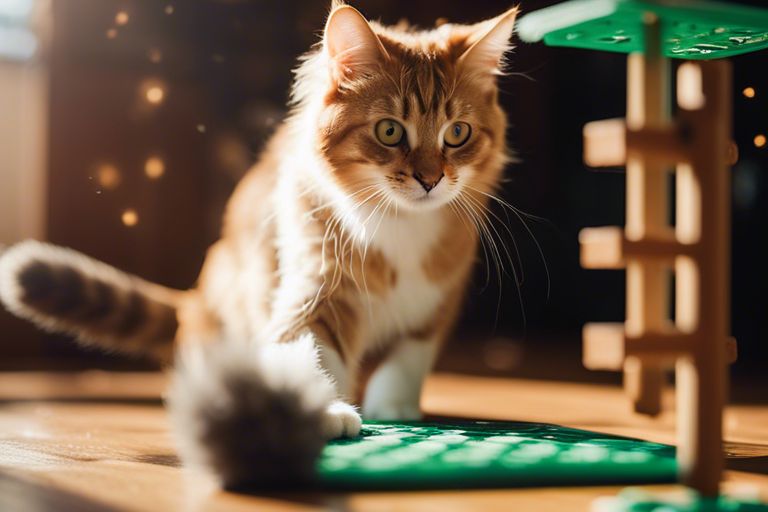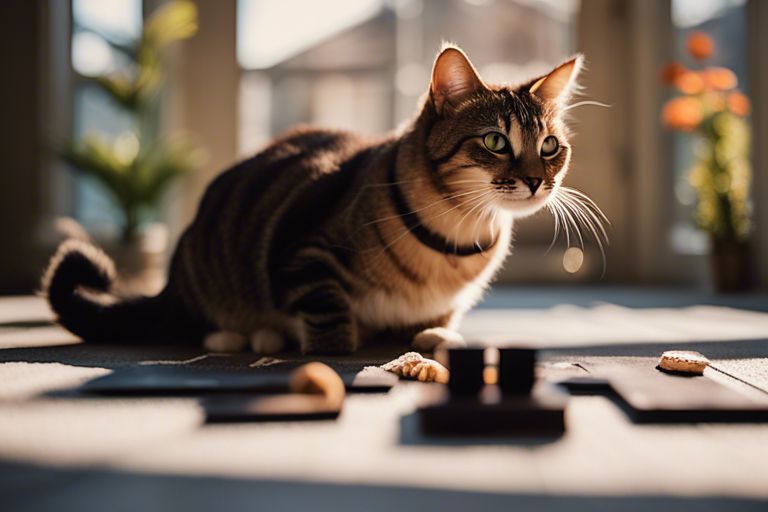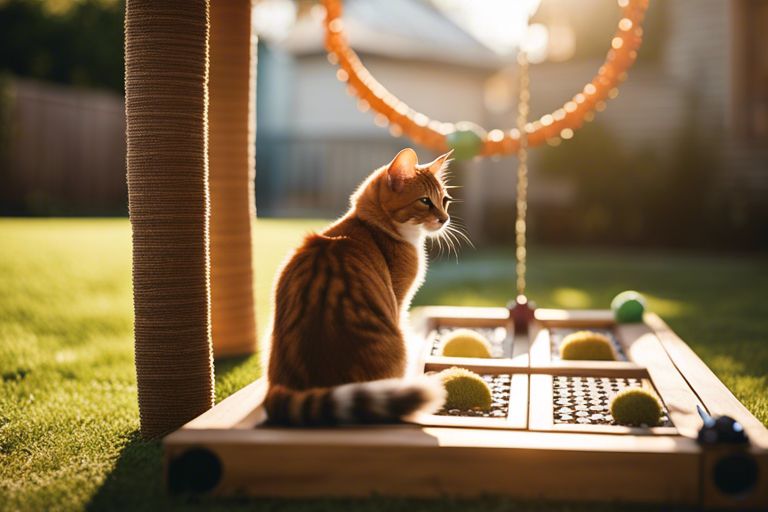Have you ever wondered how to stimulate your cat to be more active and engaged in their daily routine? It’s important to keep your feline friend healthy and fit to avoid obesity and related health problems. In this blog post, we will explore five effective methods for training your cat to be more active and energetic on a daily basis. Whether your cat is an indoor or outdoor feline, these techniques are tailored to help improve their physical and mental well-being. So let’s get started!
Key Takeaways:
- Consistency is key: Training a cat to be more active requires consistent reinforcement of desired behaviors.
- Use positive reinforcement: Reward your cat with treats or playtime when they engage in active behavior.
- Provide stimulating environments: Set up interactive toys, climbing structures, and hiding spots to encourage your cat to be more active.
- Set a regular play schedule: Dedicate specific times each day to engage in interactive play with your cat to help them be more active.
- Consult a professional: If you’re struggling to train your cat to be more active, consider seeking advice from a professional animal behaviorist or veterinarian.


Understanding Cat Behavior
One of the first steps in training your cat to be more active is to understand its natural behavior and instincts. Cats have a strong sense of independence and are natural hunters, which means they need mental and physical stimulation to stay healthy and happy.
Natural Instincts and Play Patterns
Cats have a built-in need to hunt, stalk, and pounce. This natural instinct is often seen in their play patterns, as they chase after toys or play with other animals. Understanding these play patterns can help you engage with your cat in a way that satisfies their natural instincts, keeping them active and mentally stimulated.
Motivations and Rewards
Understanding what motivates your cat is key to training them to be more active. Cats are often motivated by rewards, such as food, treats, or praise. By using positive reinforcement, you can encourage your cat to engage in more active behaviors. You can also use toys and interactive play to provide mental and physical stimulation for your cat.
Interactive Play Techniques
Now that you understand the importance of keeping your cat active, let’s talk about some interactive play techniques you can use to engage your furry friend in physical activity. Interactive play is a great way to bond with your cat while also encouraging them to be more active.
Use of Toys and Catnip
When engaging in interactive play with your cat, using toys and catnip can be highly effective in capturing their attention and stimulating their natural hunting instincts. Toys such as feather wands, laser pointers, and interactive puzzle toys can keep your cat engaged and active. Incorporating catnip into the mix can also be a great way to entice your cat to play and create a more stimulating play environment.
Structured Play Sessions
Structured play sessions can be incredibly beneficial in getting your cat to be more active. Designating specific times throughout the day for play can help establish a routine and encourage your cat to engage in physical activity. Set aside 10-15 minutes in the morning and evening to engage in active play with your cat. During these sessions, make sure to use toys that allow for pouncing, jumping, and chasing to get your cat moving and expending energy.
Environment Enrichment Strategies
After addressing your cat’s diet and exercise routine, it’s time to focus on their environment. Cats require mental and physical stimulation to stay active and engaged. By enriching their surroundings, you can encourage them to engage in more active behaviors.
Creating a Stimulating Habitat
Creating a stimulating habitat for your cat is essential for encouraging them to be more active. Include a variety of toys such as interactive toys, puzzle feeders, and scratching posts to engage their natural instincts. Consider rotating the toys regularly to keep your cat interested and provide opportunities for exploration. Additionally, providing perches and vertical space in your home can encourage climbing and jumping, which are great for keeping your cat active.
Schedule and Routine Development
Developing a consistent schedule and routine for your cat can also help improve their activity levels. Plan interactive play sessions with your cat at specific times throughout the day. Using a laser pointer or feather wand can help engage your cat in active play. You can also consider mealtime puzzles or feeding toys to encourage physical exercise while eating. By incorporating these activities into your daily routine, you can ensure that your cat gets regular exercise and mental stimulation.

Advanced Training Exercises
However, if your cat has mastered the basic training exercises and is still yearning for more mental and physical stimulation, it may be time to incorporate some advanced training exercises into your routine. Here are some advanced methods to try:
- Clicker Training for Cats
- Agility Training and Obstacle Courses
Clicker Training for Cats
If you’ve already established a positive reinforcement system with your cat, you may want to take it up a notch with clicker training. This method involves using a small clicker to mark the precise moment when your cat performs a desired behavior, followed by a treat as a reward. The sound of the clicker becomes a signal for your cat that they have done something right, and they will learn to associate it with positive reinforcement. Clicker training can be used to teach your cat more complex tricks and behaviors, and it can be a fun and engaging way to keep them mentally sharp and physically active.
Agility Training and Obstacle Courses
If you’re looking to challenge your cat’s physical abilities, agility training and obstacle courses can be a great way to do so. You can set up a simple obstacle course in your home using items like hula hoops, tunnels, and small jumps for your cat to navigate through. This kind of training can help improve your cat’s coordination, balance, and agility. Plus, it’s a great way to provide them with physical exercise and mental stimulation. Just remember to start with low, easy obstacles and gradually increase the difficulty as your cat becomes more confident and skilled.
Monitoring Progress and Health
Despite your best efforts to train your cat to be more active, it’s important to regularly monitor their progress and overall health. This involves keeping a close eye on their activity levels, weight, and overall well-being. By doing so, you can ensure that your cat’s increased activity is not negatively impacting their health.
Setting Goals and Milestones
When training your cat to be more active, it’s important to set specific goals and milestones to track their progress. This could include increasing their daily playtime, encouraging them to use a scratching post, or even introducing them to interactive toys. By setting these goals, you can keep track of your cat’s progress and make adjustments to their routine as needed.
Regular Activity Tracking and Veterinary Advice
Regularly tracking your cat’s activity levels is crucial in ensuring that they are staying healthy and active. Keep an eye on how much they are playing and their overall energy levels. Additionally, it’s important to consult with your veterinarian to receive professional advice on your cat’s activity level and overall health. Your vet can provide valuable insights and recommendations for keeping your cat active in a safe and healthy way.
Conclusion
Hence, it is important to remember that training a cat to be more active takes time and patience. By using methods such as interactive play, environmental enrichment, and regular exercise, you can help your cat become more active and healthy. Remember to be consistent and provide positive reinforcement during training sessions to encourage your cat to engage in physical activity. With dedication and the right approach, you can successfully train your cat to be more active and improve their overall well-being.
FAQ – Training a Cat to be More Active
Q: What are some effective methods for training a cat to be more active?
A: Some effective methods for training a cat to be more active include providing engaging toys and interactive play sessions, creating a stimulating environment with climbing structures and scratching posts, and incorporating food puzzles and treat-dispensing toys for mental and physical stimulation.
Q: Are there specific toys or tools that can help encourage a cat to be more active?
A: Yes, there are several toys and tools that can help encourage a cat to be more active. Interactive toys such as feather wands, laser pointers, and catnip-filled toys can stimulate a cat’s natural hunting instincts. Additionally, climbing trees, shelves, and scratching posts provide opportunities for exercise and mental stimulation.
Q: How can I establish a regular exercise routine for my cat?
A: To establish a regular exercise routine for your cat, schedule daily play sessions at the same time each day. Offer a variety of toys and activities to keep your cat engaged and excited. Gradually increase the duration and intensity of the play sessions to help your cat build endurance and improve physical fitness. It’s important to be consistent and patient as you work to establish a regular exercise routine for your cat.

Jayley, a devoted cat enthusiast, also writer for other cat blog as well. She aims to dedicated to providing comprehensive information, insights, and advice on everything you’d ever want to know about our whiskered companions.
